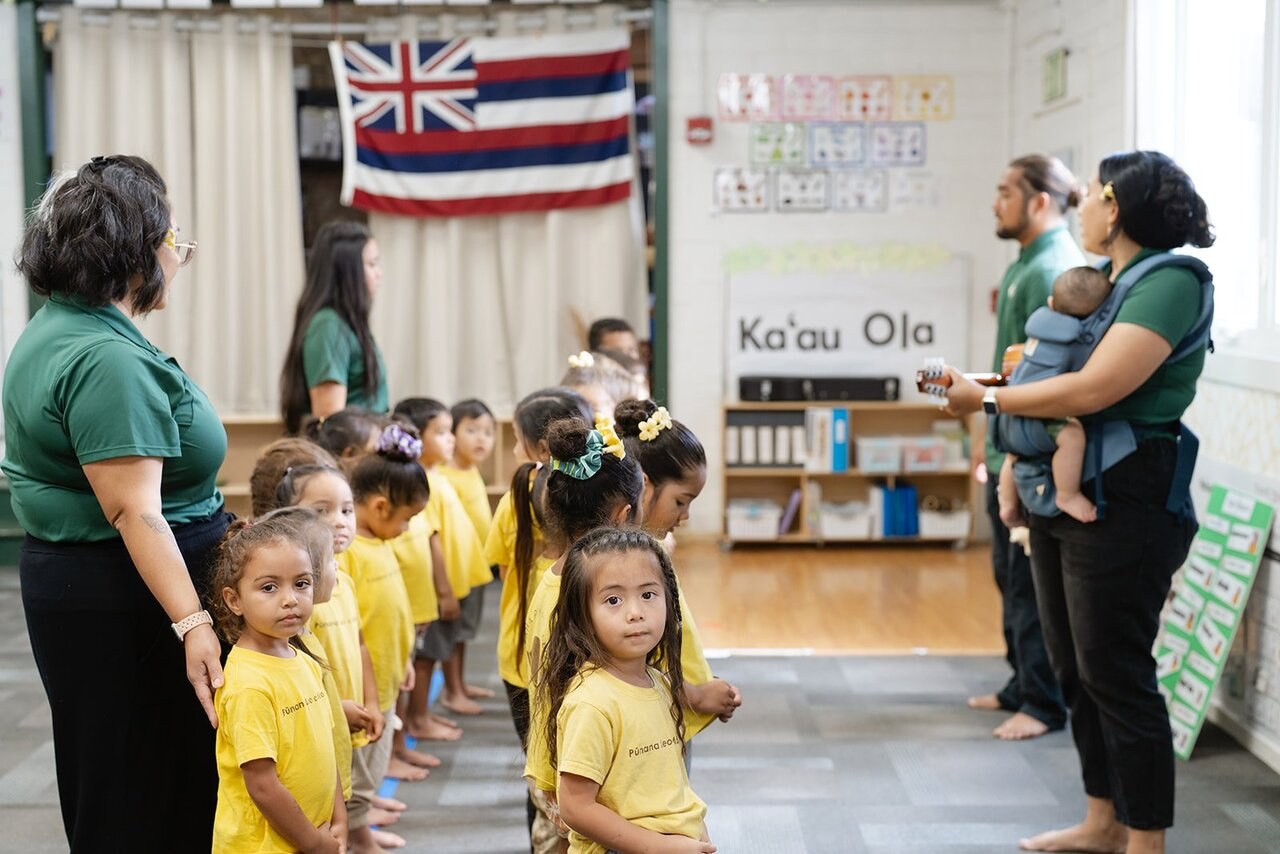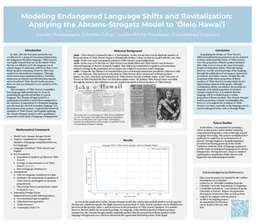Project Outline: Modeling Endangered Language Shifts and Revitalization: Applying the Abrams-Strogatz Model to 'Ōlelo Hawai'i

Supervised By: Professor Meredith Landman, Director of Undergraduate Studies in Linguistics, Columbia University
Project Background & Objective
In 1896, following the illegal overthrowing of the Hawaiian monarchy, the U.S. territorial government banned 'Ōlelo Hawai'i in an attempt to promote English as the primary language in schools, government, and businesses. Nearly 100 years later, as the ban on 'Ōlelo Hawai'i was lifted, the number of fluent speakers had dwindled to a mere 2,000, with only 50 speakers under the age of 18. Through the implementation of Hawaiian immersion preschools and through radio programs in 'Ōlelo Hawai'i, the language was remarkably revitalized, as today, there are nearly 20,000 fluent speakers of 'Ōlelo Hawai'i. Having been a teacher at a Spanish immersion preschool, the role of early language immersion in revitalizing 'Ōlelo Hawai'i piqued my interest. Furthermore, I am continually intrigued by the stakes of endangered languages—what happens when a language dies? How does a dying language impact culture?
For this project, I am interested in continuing to study endangered languages, specifically 'Ōlelo Hawai'i, while applying my mathematical background to the field of linguistics by means of the Abrams-Strogatz model. The Abrams-Strogatz model is a mathematical model that studies the competition between two languages in a given society, which can yield insight into how the endangerment of one language can be driven by the existence and imposition of another language. In the context of the Abrams-Strogatz model, prestige refers to the perceived social and economic value associated with a language. A language with higher prestige is more likely to be adopted as it is seen as more useful for education, employment, or social mobility. Historically, in Hawai'i, English has held higher prestige, especially following the 1896 ban. However, efforts to revitalize 'Ōlelo Hawai'i aim to increase its prestige by reestablishing its use in schools, media, and cultural institutions. I plan on applying the Abrams-Strogatz model to 'Ōlelo Hawai'i and English in an attempt to better understand how this model can capture historical patterns of language shift. Through this approach, my project aims to contribute a quantitative perspective to the broader conversation about language endangerment, revitalization, and policy efficacy in Hawai'i.
Research Questions
- How do different levels of prestige in the Abrams-Strogatz model affect long-term language stability or extinction in the case of 'Ōlelo Hawai'i vs. English?
- Does the 'Ōlelo Hawai'i case study suggest any sociolinguistic limits of the Abrams-Strogatz model?
- How has the prestige of 'Ōlelo Hawai'i shifted over time? Can this shift be meaningfully quantified for math modeling purposes?
Methodology
For my project, I plan on employing a mixed-methods approach, combining mathematical modeling with qualitative insights to examine language shift and revitalization in Hawai'i through the lens of the Abrams-Strogatz model.
For the mathematical modeling portion of my project, I will use the Abrams-Strogatz model to simulate competition between 'Ōlelo Hawai'i and English. In using the Abrams-Strogatz model, I plan on simulating the model by manipulating the prestige factor, transition rate, and initial speaker proportions based on different scenarios, including the post-1896 language ban period and the post-1980s immersion efforts. Furthermore, I plan on exploring future projections based on different governmental policy interventions, specifically in regard to K-12 'Ōlelo Hawai'i educational programs.
To ground this mathematical model, I will interview Dr. Larry Kimura, the godfather of the 'Ōlelo Hawai'i Revitalization Movement and founder of the Hawaiian immersion preschools, in order to provide qualitative background on the history and significance of 'Ōlelo Hawai'i.
The model results will be compared with historical data and revitalization milestones to evaluate accuracy of the Abrams-Strogatz model and to generate discussion surrounding linguistic policy efficacy in Hawai'i.
Output
By the end of my project, I aim to produce a research paper that summarizes the accuracy of the Abrams-Strogatz model in reference to the 'Ōlelo Hawai'i vs. English case study. In addition to summarizing the mathematical modeling portion of my project, my paper will also provide a qualitative perspective by integrating my interview with Dr. Larry Kimura and archival documents on 'Ōlelo Hawai'i. This project is significant, not only to me, but also to the broader community. We are surrounded by languages, both commonly spoken and endangered. It is our collective responsibility to be aware of these languages and to have discussions on what we can do to preserve them. Engaging in this research project will allow me to spearhead critical discussions regarding how policy plays into the survival of endangered languages, and will enable me to draw upon my mathematical background to further linguistic research. Languages are the foundation of any culture, and are a means of connection. The power of languages never ceases to excite me—I aspire to share that intrigue and passion with the rest of my community this summer through my research.


Please sign in
If you are a registered user on Laidlaw Scholars Network, please sign in